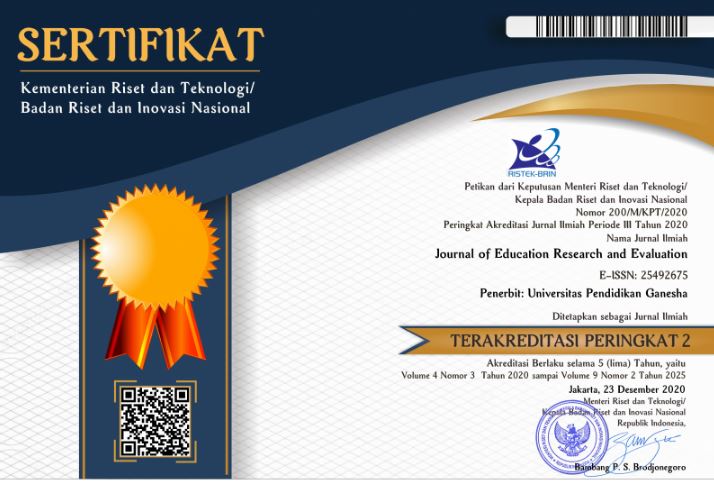Factors Affecting the Economics Learning Outcomes: Discipline Character, Learning Motivation, and Teaching Variations
DOI:
https://doi.org/10.23887/jere.v7i2.51164Keywords:
Learning Discipline, Learning Motivation, Teaching Variations, Learning OutcomesAbstract
The success or failure of a student in education depends on the learning process experienced by the student. The teachers can provide more varied learning in order to improve student learning outcomes. This study aims to analyze the influence of the character of discipline and learning motivation as well as variations in teaching on the economics learning outcomes of students in grade X. The type of research used is explanatory research with survey method. The population in the study were all students in class X high school, using random sampling so that the research sample was all participants in class X high school. The research instrument used in this study was a questionnaire while the learning outcomes were taken from the student's learning scores. The data analysis technique in this study is to use path analysis (path analysis) in its implementation is carried out through the SPSS program. There is an influence between student characters on student learning outcomes. The character of discipline and learning motivation have a positive effect on student learning outcomes because learning outcomes will increase if the character of learning discipline increases and is followed by learning motivation and student learning outcomes can be bad if students are not instilled with the character of discipline and motivation in learning. Variations given by the teacher can develop student learning outcomes if they have various kinds of teaching variations.
References
Akoto, O. Y. (2020). Metadiscourse within a discipline: A study of introduction and literature review chapters of sociology masters’ theses. Indonesian Journal of Applied Linguistics, 10(2), 471–480. https://doi.org/10.17509/ijal.v10i2.28588.
Amin, A., Kurniawan, D. A., Septi, S. E., & Zannah, M. (2021). The Study of Differences and Influences of Teacher Communication and Discipline Characters of Students. Jurnal Ilmiah Sekolah Dasar, 5(4), 622–630. https://doi.org/10.23887/jisd.v5i4.39546.
Anggraini, Y., Patmanthara, S., & Purnomo. (2017). Pengaruh Lingkungan Belajar Dan Disiplin Belajar Terhadap Hasil Belajar Kompetensi Keahlian Elektronika Industri Di Sekolah Menengah Kejuruan. Jurnal Pendidikan: Teori, Penelitian, Dan Pengembangan, 2(12), 1650–1655. https://doi.org/10.17977/jptpp.v2i12.10316.
Asad, M. M., Hassan, R. Bin, Sherwani, F., Abbas, Z., Shahbaz, M. S., & Soomro, Q. M. (2019). Identification of effective safety risk mitigating factors for well control drilling operation: An explanatory research approach. Journal of Engineering, Design and Technology, 17(1), 218–229. https://doi.org/10.1108/JEDT-04-2018-0068.
Asniar, A., K, A., & Jafar, M. I. (2022). Hubungan antara Variasi Mengajar Guru dengan Motivasi Belajar Siswa Sekolah Dasar. JPPSD: Jurnal Pendidikan Dan Pembelajaran Sekolah Dasar, 2(1), 160. https://doi.org/10.26858/pjppsd.v2i1.27377.
Asrial, A., Syahrial, S., Maison, M., Kurniawan, D. A., & Putri, E. (2021). Fostering Students’ Environmental Care Characters Through Local Wisdom-Based Teaching Materials. JPI (Jurnal Pendidikan Indonesia), 10(1), 152. https://doi.org/10.23887/jpi-undiksha.v10i1.27744.
Bak-Coleman, J. B., Alfano, M., Barfuss, W., Bergstrom, C. T., Centeno, M. A., Couzin, I. D., Donges, J. F., Galesic, M., Gersick, A. S., Jacquet, J., Kao, A. B., Moran, R. E., Romanczuk, P., Rubenstein, D. I., Tombak, K. J., Van Bavel, J. J., & Weber, E. U. (2021). Stewardship of global collective behavior. Proceedings of the National Academy of Sciences, 118(27). https://doi.org/10.1073/pnas.2025764118.
Batubara, F., Derin, T., Putri, N. S., & Yudar, R. S. (2020). Five Factors Influencing the Students’ Motivation to Learn English as a Foreign Language: A Closer Look into Montessori Classroom Environment. REiLA : Journal of Research and Innovation in Language, 2(2), 76–84. https://doi.org/10.31849/reila.v2i2.3165.
Berková, K., Borůvková, J., & Lízalová, L. (2018). Motivation of students of economic and technical study programmes as a tool of competitiveness of universities and colleges: Empirical study. Journal on Efficiency and Responsibility in Education and Science, 11(4), 72–77. https://doi.org/10.7160/eriesj.2018.110401.
Darmaji, D., Astalini, A., Kurniawan, D. A., & Perdana, R. (2019). A study relationship attitude toward physics, motivation, and character discipline students senior high school, in Indonesia. International Journal of Learning and Teaching, 11(3), 99–109. https://doi.org/10.18844/ijlt.v11i3.4207.
Elshareif, E., & Mohamed, E. A. (2021). The effects of E-learning on students’ motivation to learn in higher education. Online Learning Journal, 25(3), 128–143. https://doi.org/10.24059/olj.v25i3.2336.
Ghani, A., Usman, M., Zainal, G., & Manasiq, A. S. (2022). Eduthink: Jurnal Pemikiran Islam Pengaruh Motivasi Belajar Terhadap Hasil Belajar Siswa. Jurnal Pendidikan Pemikiran Islam, 03(01), 22–32. https://ejournal.iaimu.ac.id/index.php/eduthink/article/view/124.
Kalaja, P., Barcelos, A. M. F., Aro, M., Ruohotie-Lyhty, M., & Barcelos, A. M. F. (2016). Student teachers’ beliefs and motivation, and the shaping of their professional identities. Beliefs, Agency and Identity in Foreign Language Learning and Teaching, 71–96. https://doi.org/10.1057/9781137425959_5.
Kapon, S., Laherto, A., & Levrini, O. (2018). Disciplinary authenticity and personal relevance in school science. Science Education, 102(5), 1077–1106. https://doi.org/10.1002/sce.21458.
Kusdaryani, W., Purnamasari, I., & Tika Damayani, A. (2016). Penguatan Kultur Sekolah Untuk Mewujudkan Pendidikan Ramah Anak. Jurnal Cakrawala Pendidikan, 1(1), 125–133. https://doi.org/10.21831/cp.v1i1.8383.
McGovern, J., Mele, M., & Ragudaran, S. (2021). Community-Based Research in Practice: Faculty Reflections on a Collaborative Approach to Teaching CBR With a Variety of Community Partners. Journal of Higher Education Outreach and Engagement, 25(4), 153–166. https://ojs01.galib.uga.edu/jheoe/article/view/1478.
Meiriza, M. S. (2015). Students’ Perception on the Prospect of Economics Education Study Program. Journal of Education and Practice, 6(28), 144–151. https://eric.ed.gov/?id=EJ1081248.
Muhammad, U., & Widyanto, A. (2019). Internalisasi Nilai-Nilai Toleransi dalam Pembelajaran Pendidikan Agama Islam di SMA Negeri 1 Lhokseumawe. DAYAH: Journal of Islamic Education, 2(1), 36–52. https://doi.org/http://dx.doi.org/10.22373/jie.v2i1.2939.
Mukhtar, S., & Putri, K. Y. S. (2021). Technology integrated on media literacy in economic studies on higher education. Journal of Social Studies Education Research, 12(1), 95–123. https://www.learntechlib.org/p/219409.
Murniyetti, M., Engkizar, E., & Anwar, F. (2016). Pola Pelaksanaan Pendidikan Karakter Terhadap Siswa Sekolah Dasar. Jurnal Pendidikan Karakter, 6(2), 156–166. https://doi.org/10.21831/jpk.v6i2.12045.
Mustika, W., & Rahmi, E. (2019). Pengaruh Variasi Mengajar Guru dan Minat Belajar Siswa Terhadap Hasil Belajar Siswa Kelas X IS SMA Pertiwi 1 Padang Pada Mata Pelajaran Ekonomi Tahun Ajaran 2018/2019. Jurnal Ecogen, 2(4), 798. https://doi.org/10.24036/jmpe.v2i4.7857.
Nirtha, E. N., Ismanto, B. I., & Sulasmono, B. S. (2021). LCL Model experiential learning based training model development to improve teacher competence in designing learning. JPI (Jurnal Pendidikan Indonesia), 10(3), 430–440. https://doi.org/10.23887/jpi-undiksha.v10i3.33832.
Nurmila, N., Umar, M. K., & Abdjul, T. (2022). Variety of Teaching Material on Online Learning and Physics Learning Outcomes in Gorontalo District High Schools. Jurnal Pendidikan Fisika Dan Teknologi, 8(1), 48–55. https://doi.org/10.29303/jpft.v8i1.3501.
Nurrokhmanti, H., Claramita, M., & Utomo, P. S. (2016). Among Students’ Internal Factors, Should Motivation be Used as One of Recruitmen for Admission of Medical Students in Indonesia? Jurnal Pendidikan Kedokteran Indonesia: The Indonesian Journal of Medical Education, 5(2), 59. https://doi.org/10.22146/jpki.25316.
Oweis, T. I. (2018). Effects of Using a Blended Learning Method on Students’ Achievement and Motivation to Learn English in Jordan: A Pilot Case Study. Education Research International, 2018. https://doi.org/10.1155/2018/7425924.
Pappas, M. A., Papoutsi, C., & Drigas, A. S. (2018). Policies, practices, and attitudes toward inclusive education: The case of Greece. Social Sciences, 7(6). https://doi.org/10.3390/SOCSCI7060090.
Purwati, E., & Akmaliyah, M. (2016). Hubungan antara Self Efficacy dengan Flow Akademik pada Siswa Akselerasi SMPN 1 Sidoarjo. Psympathic : Jurnal Ilmiah Psikologi, 3(2), 249–260. https://doi.org/10.15575/psy.v3i2.1113.
Putri, W. A., Fitriani, R., Rini, E. F. S., Aldila, F. T., & Ratnawati, T. (2021). Pengaruh Motivasi Terhadap Hasil Belajar Siswa Sekolah Menengah Pertama. Jurnal Pembelajaran Dan Matematika Sigma (Jpms), 7(1), 7–11. https://doi.org/10.36987/jpms.v7i1.1942.
Qian, Y., Liu, Y., & Sheng, Q. Z. (2020). Understanding hierarchical structural evolution in a scientific discipline: A case study of artificial intelligence. Journal of Informetrics, 14(3), 101047. https://doi.org/10.1016/j.joi.2020.101047.
Santana-Monagas, E., Putwain, D. W., Núñez, J. L., Loro, J. F., & León, J. (2022). Do teachers’ engaging messages predict motivation to learn and performance? Revista de Psicodidáctica (English Ed.), 27(1), 86–95. https://doi.org/10.1016/j.psicoe.2021.11.001.
Shanks, N. (2019). Economics (Only) now: The temporal limitations of economics as part of a critical social studies pedagogy. Education Sciences, 9(1). https://doi.org/10.3390/educsci9010036.
Shilfani, S., Taula’bi’, N., Sudarsi, E. T., Girik Allo, M. D., & Kristanto, K. (2022). The Learning of Toraja Language Variations: The Students’ Attitudes, Attendance, Activity Change, and Learning outcomes in Ke’te’ Kesu’ Toraja Tourism Site Context. JPI (Jurnal Pendidikan Indonesia), 11(1), 19–26. https://doi.org/10.23887/jpi-undiksha.v11i1.28622.
Skaraki, E., Kalogiannakis, M., Ampartzaki, M., & Papadakis, S. (2018). Teaching natural science concepts to young children with mobile devices and hands-on activities. A case study. International Journal of Teaching and Case Studies, 9(2), 171. https://doi.org/10.1504/ijtcs.2018.10011893.
Sugiarto, A. P., Suyati, T., & Yulianti, P. D. (2019). Faktor Kedisiplinan Belajar Pada Siswa Kelas X Smk Larenda Brebes. Mimbar Ilmu, 24(2), 232. https://doi.org/10.23887/mi.v24i2.21279.
Sunarto, A., Warni Tanjung, A., & Ellesia, N. (2020). Teacher Performance Based on The Visionary Leadership Style of School, Competency and Work Discipline (Study at Muhammadiyah Setiabudi Pamulang College). Journal of Research in Business, Economics, and Education, 2(4), 325–336. http://e-journal.stie-kusumanegara.ac.id/index.php/jrbee/article/view/162.
Suprihatin. (2015). Upaya Guru Dalam Meningkatkan Motivasi Belajar Siswa. Jurnal Pendidikan Ekonomi, 3(1), 73–82. https://doi.org/10.31316/g.couns.v6i1.2198.
Xing, L., Sun, J. M., Jepsen, D., & Zhang, Y. (2021). Supervisor negative feedback and employee motivation to learn: An attribution perspective. Human Relations. https://doi.org/10.1177/00187267211038514.
Zheng, Y., Lu, X., & Ren, W. (2019). Profiling Chinese university students’ motivation to learn multiple languages. Journal of Multilingual and Multicultural Development, 40(7), 590–604. https://doi.org/10.1080/01434632.2019.1571074.
Zotov, V., Frolova, N., Prasolov, V., & Kintonova, A. (2021). The effectiveness of case studies in entrepreneurship education. International Journal of Instruction, 14(4), 1033–1046. https://doi.org/10.29333/iji.2021.14459a.
Downloads
Published
How to Cite
Issue
Section
License
Copyright (c) 2023 Suratno, Ekawarna, Rachmad, Suardi

This work is licensed under a Creative Commons Attribution-ShareAlike 4.0 International License.
Authors who publish with the Journal of Evaluation and Research in Education (JERE) agree to the following terms:
- Authors retain copyright and grant the journal the right of first publication with the work simultaneously licensed under a Creative Commons Attribution License (CC BY-SA 4.0) that allows others to share the work with an acknowledgment of the work's authorship and initial publication in this journal.
- Authors are able to enter into separate, additional contractual arrangements for the non-exclusive distribution of the journal's published version of the work (e.g., post it to an institutional repository or publish it in a book), with an acknowledgment of its initial publication in this journal.
- Authors are permitted and encouraged to post their work online (e.g., in institutional repositories or on their website) prior to and during the submission process, as it can lead to productive exchanges, as well as earlier and greater citation of published work. (See The Effect of Open Access)











